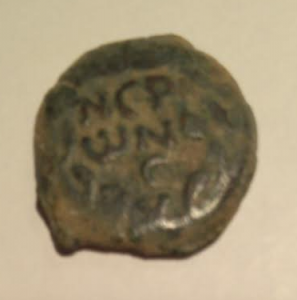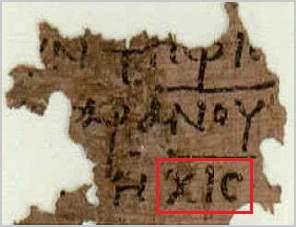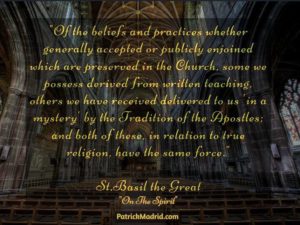Here’s a very interesting article by Gary DeMar that will certainly challenge much current thinking about the identity of the Beast in the book of Revelation. (original source here)
Dr. R. C. Sproul has come to similar conclusions – see his lecture on “The Beast” at this link)
This comment was made in a post about the number of the Beast (Revelation 13:18): “This calls for wisdom: let the one who has understanding calculate the number of the beast, for it is the number of a man, and his number is 666.”
The question is: Why should we use Hebrew gematria in a book that is written in Greek for the Greek speaking churches of Asia Minor?
Gematria is an interpretive method that assigns numerical value to letters, words, and phrases. Most of us are unfamiliar with this method since we have a separate alphabet and numbering system.
Anybody familiar with the Bible understands that numbers are important. Some see gematria everywhere in Scripture. I have Theomatics: God’s Best Secret Revealed and The Original Code in the Bible: Using Science and Mathematics to Reveal God’s Fingerprints in mind. This is not to dismiss the idea that some, maybe many, Bible numbers have a deeper symbolic meaning, especially when the Bible tells us in the case of Revelation 13:18 to “calculate the number of the beast.”
When trying to match up “six hundred and sixty-six” with a known historical figure, we need more than a plausible candidate; we need a relevant candidate. The first readers of Revelation were told to “calculate the number of the beast, for the number is that of a man; and his number is six hundred and sixty-six” (13:18). Since Revelation was written to a first-century audience (“these things must shortly take place . . . for the time is near . . . the hour of testing is about to come on the land. . . . Do not seal up the words of the prophecy of this book for the time is near”: 1:1, 3; 3:10, 22:10), we should expect some first-century readers to have been able to calculate the number with relative ease and understand the result. They would have had few candidates from which to choose. It’s unlikely that this number of a man identifies someone outside their time of reference. The same is true of the rest of the book.
Notice that the number is “six hundred and sixty-six,” not three sixes. Tim LaHaye misidentifies the number when he writes, “The plain sense of Scripture tells us that it comprises the numbers: six, six, six.”1 The three Greek letters that make up the number represent 600 (ἑξακόσιοι), 60 (ἑξήκοντα), and 6 (ἕξ).
NEPΩN KAIΣAP
Ancient numbering systems used an alphanumeric method. This is true of the Latin (Roman) system that is still common today: I = 1, V = 5, X = 10, L = 50, C = 100, D = 500, M = 1,000.
Greek and Hebrew follow a similar method: each letter of each alphabet represents a number. The first nine letters represent 1–9. The tenth letter represents 10, with the nineteenth letter representing 100 and so on. Since the book of Revelation is written in a Hebrew context by a Jew with numerous allusions to the Old Testament, we should expect the solution to deciphering the meaning of six hundred and sixty-six to be Hebraic. “The reason clearly is that, while [John] writes in Greek, he thinks in Hebrew, and the thought has naturally affected the vehicle of expression.”2
Is there anything in John’s writings, especially in Revelation, that hints at this use of both Greek and Hebrew? The “angel of the abyss” is described in two ways: “His name in Hebrew is Abaddon, and in the Greek he has the name Apollyon” (Rev. 9:11). Something similar was done with “Har-Magedon” (hill of Megiddo) or “Ar-Magedon” (city of Megiddo) (Rev. 16:16). Megiddo was an Old Testament city (1 Chron. 7:29), the place where King Josiah was killed (2 Chron. 35:20–27). There are references to Egypt and Sodom (Rev. 11:8), Jezebel (2:20), Balaam (2:14), Babylon (17-18), the attire of the high priest (17:4-5).
Of the 404 verses of the book of Revelation, 278 are based directly on Old Testament language and thought. . . . The author of Revelation does not intend to show that Old Testament predictions are fulfilled in events involving Christ and the church. Instead, he used Old Testament language to describe the situation facing his readers. He draws parallels between Old Testament events and ideas and the circumstances in which he and his readers find themselves.3
For a comprehensive list, see “Old Testament References in the Book of Revelation” by Arnold G. Fruchtenbaum.
In John’s gospel, the place where Pilate sat down to judge Jesus was called “The Pavement,” but John called attention to its Hebrew (Jewish Aramaic) name “Gabbatha” (John 19:13). In the same chapter, John wrote how Pilate had an inscription placed on the cross above Jesus’ head written in “Hebrew, Latin, and in Greek” (John 19:20). Going from Greek to Hebrew was typical and expected since Jews spoke Hebrew or Jewish Aramaic which is very similar to Hebrew.
For a fully study of this topic, see William Henry Guillemard’s Hebraisms in the Greek Testament.
So what name is behind the cryptic 666? When Nero Caesar’s name is transliterated into Hebrew, which a first-century Jew would probably have done immediately, he would have gotten Neron Kesar or simply nrwn qsr, since Hebrew has no letters to represent vowels. (The w represents a long “o” sound and the q represents the “k” sound in Hebrew.) “It has been documented by archaeological finds that a first century Hebrew spelling of Nero’s name provides us with precisely the value of 666. Jastrow’s lexicon of the Talmud contains this very spelling.”4 When we take the letters of Nero’s name and spell them in Hebrew, we get the following numeric values: n = 50, r = 200, w = 6, n = 50, q = 100, s = 60, r = 200. Put together, the sum is 666.
 Every Jewish reader, of course, saw that the Beast was a symbol of Nero. And both Jews and Christians regarded Nero as also having close affinities with the serpent or dragon . . . The Apostle writing as a Hebrew, was evidently thinking as a Hebrew . . . Accordingly, the Jewish Christian would have tried the name as he thought of the name—that is in Hebrew letters. And the moment that he did this the secret stood revealed. No Jew ever thought of Nero except as “Neron Kesar.”5
Every Jewish reader, of course, saw that the Beast was a symbol of Nero. And both Jews and Christians regarded Nero as also having close affinities with the serpent or dragon . . . The Apostle writing as a Hebrew, was evidently thinking as a Hebrew . . . Accordingly, the Jewish Christian would have tried the name as he thought of the name—that is in Hebrew letters. And the moment that he did this the secret stood revealed. No Jew ever thought of Nero except as “Neron Kesar.”5
I have a coin (see right) that spells Nero’s name as NERŌN. Coins were struck with the spelling NEPΩN KAIΣAP ΣEBAΣTOΣ = “Neron Caesar Augustus.”
 Richard Bauckham writes:
Richard Bauckham writes:
The solution to the riddle of 666 which has been most widely accepted since it was first suggested in 1831 is that 666 is the sum of the letters of Nero Caesar written in Hebrew characters as נרון קסר (נ = 50 + ר = 200 + ו = 6 + ן = 50 + ק = 100 + ס = 60 + ר = 200). Few of the many other solutions by gematria which have been proposed offer a name, which the phrase ‘the number of his name’ (Rev. 13:17; 15:2) requires, and of those few which do this seems eminently the most preferable.6
A textual variant in some New Testament manuscripts has the number of the Beast as 616 based on the reading of nrw qsr — Nero Caesar — instead of “the Greek form Nerwn, . . . so that the final ן is omitted from נרון , the numerical value becomes 616.”7
Solomon and 666
 The Jews had seen the number six hundred and sixty-six before (not 6-6-6 but 600+60+6= 666). Prior to Solomon’s slide into apostasy, a description of his reign is given. One of the things said about him is that “the weight of gold which came in to Solomon in one year was 666 talents of gold” (1 Kings 10:14). From the number of shields (300) to the price of a horse imported from Egypt (150 shekels), we find round numbers, except when the number of gold talents is mentioned. Why not 650 or even 660? Why 666?
The Jews had seen the number six hundred and sixty-six before (not 6-6-6 but 600+60+6= 666). Prior to Solomon’s slide into apostasy, a description of his reign is given. One of the things said about him is that “the weight of gold which came in to Solomon in one year was 666 talents of gold” (1 Kings 10:14). From the number of shields (300) to the price of a horse imported from Egypt (150 shekels), we find round numbers, except when the number of gold talents is mentioned. Why not 650 or even 660? Why 666?
From the point where we are told that 666 talents of gold came into Solomon’s possession in one year, we read of Solomon’s apostasy. First, Solomon violates the law regarding the accumulation of horses, chariots, wives, and gold (1 Kings 10:26; see Deut. 17:16-17).
The law of Deuteronomy 17 forbad the king to multiply gold, women, and horses, but here we see Solomon do all three. In Revelation, the religious rulers of the “land” are called kings, the “kings of the land.” The apostasy of the High Priest, and of the religious leaders of Israel, is thus linked to Solomon’s sin. As Solomon lost his kingdom when the northern tribes rebelled after his death, so the Land Beast will lose his kingdom permanently when Jerusalem is destroyed.8
Second, Solomon sells himself to foreign interests by marrying foreign women to create political alliances (1 Kings 11:1–2). It is here that we see a parallel with Revelation 13. In their rejection of Jesus as the promised Messiah (“He came to His own, and those who were His own did not receive Him”—John 1:11), the unbelieving Jews committed spiritual adultery with the nations (Roman Empire of nations) in the way that Solomon committed physical/spiritual adultery with the nations surrounding him:
Now Solomon loved many foreign women along with the daughter of Pharaoh: Moabite, Ammonite, Edomite, Sidonian, and Hittite women, from the nations concerning which the LORD had said to the sons of Israel, ‘You shall not associate with them, neither shall they associate with you, for they will surely turn your heart away after their gods.’ Solomon held fast to these in love. And he had seven hundred wives, princesses, and three hundred concubines, and his wives turned his heart away (1 Kings 11:1–3).
James Jordan sums up the connection between Solomon and the apostate character of the Church’s enemy in Revelation 13:
The number of the name (character) of the Sea Beast, then, means “apostate Solomon; apostate Jew.” It is Solomon, not free under Yahweh’s rule, but enslaved to Gentiles through illicit trade, the idol worshipping wiles of his women, and his lust for gold.9
It’s possible, therefore, that 666 refers to both Nero and Solomon since the Sea Beast (Roman Empire under Nero) and the Land Beast (Israel as a “synagogue of Satan”: Rev. 2:9; 3:9) cooperate in their desire to see the new covenant people of God destroyed. Those Jews who rejected Jesus (the greater David: Acts 2:25–36) embraced the apostasy of Solomon who did not follow after his father David.
Marrying foreign wives was similar to what the Jews did when they cried out at Jesus’ trial before Pontius Pilate, the civil representative of Rome, “We have no king but Caesar” (John 19:15). They aligned themselves with Rome against Jesus. This made them true antichrists (2 John 2:7; 1 John 2:18-22; 4:2-3). They chose the bastard Barabbas (“son [bar] of a father [abba]”) rather than the true son, Jesus (Son of the Father).
Nero the Beastly Character
By all accounts, Nero had a reputation as an immoral beast. “According to the emperor Marcus Aurelius [121–180], ‘To be violently drawn and moved by the lusts of the soul is proper to wild beasts and monsters, such as Phalaris and Nero were.’”10 Other histories of the period offer a similar description. But for Christians, Nero was a beast because “he was the first emperor to persecute the church.”11
Nero was an animalistic pervert. He kicked one of his pregnant wives to death. He murdered his mother. He set Christians on fire to serve as lamps for a dinner party. He would dress up as a beast and rape both male and female prisoners. And he was the covenant head of Rome—that great Satan.12
There is a long history of Christian commentators who have taught that John, through the Revelation received through Jesus, had Nero in mind as the fulfillment of what is taking place in Revelation 13 as the Sea Beast. Nero fits the historical circumstances since he was the Emperor of Rome from A.D. 54 through June of 68 and was a tyrant of first order. According to first-century Roman historian Tacitus (A.D. 56–117), Nero blamed the burning of Rome on Christians:
Consequently, to get rid of the report, Nero fastened the guilt and inflicted the most exquisite tortures on a class hated for their abominations, called Christians by the populace (Annals, 15:44).
Nero committed numerous atrocities against Christians. Some Christians were “wrapped in animal skins and torn apart by dogs; others were crucified and set aflame after being soaked in oil. Nero threw open his gardens for the spectacle and drove about in his chariot.”13
One of the reasons Nero was often identified as the Beast of Revelation 13 (the word “antichrist” is not used in Revelation) was because his name, when put into Hebrew letters, as a Jew would have done (Rev. 16:16), adds up to 666:
Every Jewish reader, of course, saw that the Beast was a symbol of Nero. And both Jews and Christians regarded Nero as also having close affinities with the serpent or dragon . . . The Apostle writing as a Hebrew, was evidently thinking as a Hebrew . . . Accordingly, the Jewish Christian would have tried the name as he thought of the name — that is in Hebrew letters. And the moment that he did this the secret stood revealed. No Jew ever thought of Nero except as “Neron Kesar.”14
Mark Wilson writes the following in his brief commentary on Revelation in the Zondervan Illustrated Bible Backgrounds Commentary: “Nero is the only first-century emperor whose name can be calculated to equal 666. Nero’s Greek name NERON KAISER was inscribed on the obverse of coins from Ephesus, Sardis, and Laodicea during this period.”15 The IVP Bible Background Commentary states that identifying Nero as the Beast and the number 666 is “the most popular proposal among scholars today.”16
There’s something else to consider. If the Greek word for beast (θηρίον = תריון) is translated “into Hebrew consonants, the numerical value comes out to 666. This appears to be what John means when he mentions in 13:18 ‘the number of the beast, for it is the number of a man, and his number is 666.’”17
Conclusion
So not only does Nero Caesar add up to 666 when transliterated into Hebrew letters, but the Hebrew transliteration of the Greek word for “beast” also comes to 666.
By paying attention to the specific time elements in Revelation and audience relevance, we can conclude that John’s Beast with a name that adds up to 666 is long dead and gone. Today’s end-time speculation is foolish and counter-productive and dilutes the Bible’s message of the finished work of Jesus Christ and the end of the old covenant system that passed away with the destruction of the temple in A.D. 70. We should focus on the name of Jesus “and the name of His Father” (Rev. 14:1). The Lamb has conquered the Beast of Revelation 13 and any beasts to follow.
Notes:
1. Tim LaHaye, Revelation Unveiled, rev. ed. (Grand Rapids, MI: Zondervan, 1999), 22–27.
2. R.H. Charles, A Critical and Exegetical Commentary on the Revelation of St. John, 2 vols. (New York: Charles Scribner’s Sons, 1920), 1:cxliii.
3. Frank Pack, “The Old Testament and the Book of Revelation.”
4. Kenneth L. Gentry, Jr., The Beast of Revelation, rev. ed. (Powder Springs, GA: American Vision, 2002), chap. 3. Also see Charles, A Critical and Exegetical Commentary on the Revelation of St. John, 1:367.
5. Frederic W. Farrar, The Early Days of Christianity (New York: E. P. Dutton, 1882), 471.
6. Richard Bauckham, The Climax of Prophecy: Studies on the Book of Revelation (Edinburgh: T&T Clark, 1993), 387.
7. Bauckham, The Climax of Prophecy, 387. Also see James Tabor, “Why 2K?: The Biblical Roots of Millennialism,” Bible Review (December 1999): http://bit.ly/WtlK30
8. James B. Jordan, A Brief Reader’s Guide to Revelation (Niceville, FL: Transfiguration Press, 1999), 36.
9. James B. Jordan, “The Beasts of Revelation (4),” Studies in Revelation (April 1996), 2.
10. Bauckham, The Climax of Prophecy, 409.
11. Bauckham, the Climax of Prophecy, 411.
12. Douglas Wilson, “666” (July 13, 2005): http://bit.ly/StHTRq
13. John Haralson Hayes, Introduction to the Bible (Louisville, KY: Westminster John Knox Press, 1971), 453.
14. Frederic W. Farrar, The Early Days of Christianity (New York: E. P. Dutton, 1882), 471.
15. Mark W. Wilson, “Revelation,” Zondervan Illustrated Bible Backgrounds Commentary, gen. ed. Clinton E. Arnold (Grand Rapids, MI: Zondervan, 2002), 4:330.
16. Craig S. Keener, The IVP Bible Background Commentary: New Testament (Downers Grove, IL: InterVarsity Press, 1993), 799.
17. Bauckham, The Climax of Prophecy, 389.





